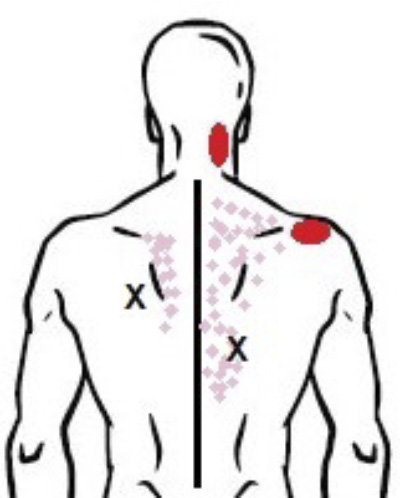Interfascial ultrasound-guided infiltration of the lower trapezius and spinal extensor muscles
- 14/02/2023
What is Interfascial Ultrasound-Guided Injection of the Lower Trapezius and Spine Extensor Muscles?
Interfascial ultrasound-guided injection between the lower trapezius and spinal extensor muscles is a procedure in which we inject a corticosteroid and a local anesthetic between the fascia of the lower trapezius and erector spinae muscles.
This interfascial ultrasound-guided injection aims to provide symptomatic relief for patients with chronic myofascial pain in this area.
As we have seen in previous articles, we can perform these injections in cases of persistent pain that does not improve with any conservative measures or in combination with rehabilitation.
What is the indication for Interfascial Ultrasound-Guided Injection of the Lower Trapezius and Spine Extensor Muscles?
- Chronic myofascial pain: This is the most important indication. It is used for patients who suffer from persistent pain in the dorsal region, often related to the presence of trigger points in the lower trapezius muscle.
- Pain resistant to other treatments: Injections are considered an option when conservative therapies, such as physical therapy, stretching, massage, or oral medications, have not provided sufficient relief.
- Radiating or referred pain: Lower trapezius pain can manifest not only in the muscle itself, but also in a referred manner to the shoulder, arm, or even the head. Injections aim to block the source of pain in the interfascial plane, where nerves and nerve endings are located.
- Fascial adhesion release: Ultrasound-guided injections of an interfascial space release potential adhesions between the muscles in question and block the nerves and nerve endings that circulate in this interfascial plane, providing symptomatic relief from chronic pain and improving inflammation and muscle function.
- Improved muscle function and scapular mobility: By relieving pain, the injection allows the patient to regain normal mobility of the scapula and shoulder, which is often impaired by muscle tension and pain.
Again, we must remember the importance of the connective tissue that covers and limits the muscles (fascia), through which the nerves, blood vessels, and small nerve endings responsible for pain circulate.
The use of ultrasound provides us with an effective, safe, and precise tool to avoid those key structures that should not be injured during the medical procedure. In Figure 1, we observe the importance of the trigger points of the lower trapezius muscle and the pattern of referred pain according to the trigger point observed.
The importance of the lower trapezius in scapular mobility is undeniable, as it is involved in elevating the shoulder, assisting the serratus anterior, and controlling the arm's drop during descent.
Interfascial ultrasound-guided injections at the lower trapezius-extensor level of the spine can reduce inflammation and pain, improve muscle function, and indirectly improve scapular mobility impairment caused by pain.
Interfascial ultrasound-guided injections of the lower trapezius and erector spinae (see Figure 2) are indicated for chronic myofascial pain that may be the cause of reduced scapular rotation and secondary loss of shoulder function. Inhibition of the lower trapezius is often related to scapular dyskinesis, which in turn can be a precursor to shoulder pain.
Chronic pain in both muscles can be due to postural causes, overload, overuse, repetitive movements, physical exertion, or myofascial injury.
Both muscles are common sites of acute and chronic pain in clinical practice. The first line of treatment is physical therapy with stretches associated with myofascial release techniques, deep gliding massages with friction, etc.
What is the procedure for an ultrasound-guided interfascial injection of the lower trapezius and erector spinae?
The ultrasound-guided interfascial injection of the lower trapezius and erector spinae is usually performed in an outpatient setting and takes 10 to 15 minutes. Here is a summary of the procedure:
- Preparation: An ultrasound is performed prior to injection, with recognition of anatomical structures and marking of the entry site on the skin.
- Local anesthesia: A small amount of local anesthesia may be applied to the skin to reduce pain during the injection.
- Asepsis: The skin is cleaned with antiseptic, and the equipment and the field are prepared under strict aseptic conditions.
- Ultrasound guidance: Ultrasound is used to guide the needle into the interfascial space of both muscles and ensure that the medication is administered in the correct location.
- Drug injection: The drug is administered through the needle, and we observe how it diffuses between both fascias.
Patients who fail to improve with various rehabilitation treatments are candidates for interfascial ultrasound-guided injections.

Figure 1: Trigger points (X) and referred pain of the lower trapezius muscle.

Figure 2: Needle access to the interfascial space between the lower trapezius and erector spinae (white line).
Book an appointment with Dr. Jordi Jiménez. He will see you at the center of Palma de Mallorca and help you regain your quality of life.

![[VIDEO] Ultrasound-Guided Injection for Trigger Finger](https://drjordijimenez.com/imagen/100/100/Imagenes/infiltracion-ecoguidada-dedo-resorte-drjordijimenez.jpg)
![[VIDEO] Ultrasound-guided infiltration of the lumbar facets](https://drjordijimenez.com/imagen/100/100/imagenes-pagina/sindrome-facetario-lumbar-drjordijimenez (1).jpg)
![[VIDEO] Ultrasound-guided infiltration of the hip joint](https://drjordijimenez.com/imagen/100/100/Imagenes/valgo-dinamico-rodilla-drjordijimenez.jpg)